SNVSBL0A November 2020 – December 2021 TPS7H4010-SEP
PRODUCTION DATA
- 1 Features
- 2 Applications
- 3 Description
- 4 Revision History
- 5 Pin Configuration and Functions
- 6 Specifications
-
7 Detailed Description
- 7.1 Overview
- 7.2 Functional Block Diagram
- 7.3
Feature Description
- 7.3.1 Synchronous Step-Down Regulator
- 7.3.2 Auto Mode and FPWM Mode
- 7.3.3 Fixed-Frequency Peak Current-Mode Control
- 7.3.4 Adjustable Output Voltage
- 7.3.5 Enable and UVLO
- 7.3.6 Internal LDO, VCC_UVLO, and BIAS Input
- 7.3.7 Soft Start and Voltage Tracking
- 7.3.8 Adjustable Switching Frequency
- 7.3.9 Frequency Synchronization and Mode Setting
- 7.3.10 Internal Compensation and CFF
- 7.3.11 Bootstrap Capacitor and VBOOT-UVLO
- 7.3.12 Power-Good and Overvoltage Protection
- 7.3.13 Overcurrent and Short-Circuit Protection
- 7.3.14 Thermal Shutdown
- 7.4 Device Functional Modes
-
8 Application and Implementation
- 8.1 Application Information
- 8.2
Typical Application
- 8.2.1 Design Requirements
- 8.2.2
Detailed Design Procedure
- 8.2.2.1 Output Voltage Setpoint
- 8.2.2.2 Switching Frequency
- 8.2.2.3 Input Capacitors
- 8.2.2.4 Inductor Selection
- 8.2.2.5 Output Capacitor Selection
- 8.2.2.6 Feed-Forward Capacitor
- 8.2.2.7 Bootstrap Capacitors
- 8.2.2.8 VCC Capacitor
- 8.2.2.9 BIAS
- 8.2.2.10 Soft Start
- 8.2.2.11 Undervoltage Lockout Setpoint
- 8.2.2.12 PGOOD
- 8.2.3 Application Curves
- 9 Power Supply Recommendations
- 10Layout
- 11Device and Documentation Support
- 12Mechanical, Packaging, and Orderable Information
Package Options
Refer to the PDF data sheet for device specific package drawings
Mechanical Data (Package|Pins)
- RNP|30
- KGD|0
Thermal pad, mechanical data (Package|Pins)
- RNP|30
Orderable Information
8.2.3 Application Curves

| VOUT = 5 V | fSW = 500 kHz | Auto Mode |

| VOUT = 5 V | fSW = 1000 kHz | Auto Mode |

| VOUT = 5 V | fSW = 2200 kHz | Auto Mode |

| VOUT = 5 V | fSW = 500 kHz | Auto Mode |
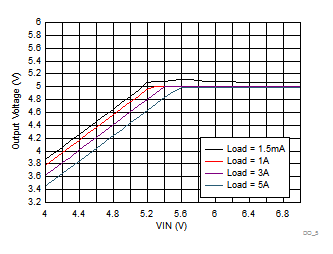
| VOUT = 5 V | fSW = 2200 kHz | Auto Mode |
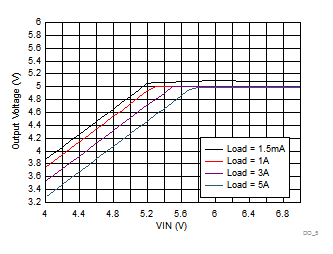
| VOUT = 5 V | fSW = 500 kHz | Auto Mode |

| VOUT = 3.3 V | fSW = 500 kHz | Auto Mode |
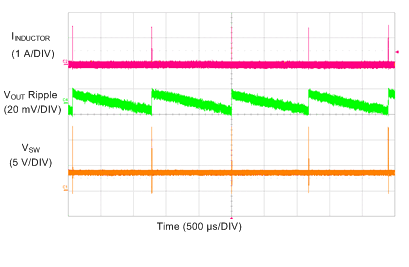
| VIN = 12 V | VOUT = 3.3 V | fSW = 500 kHz |
| IOUT = 1 mA | Auto Mode |
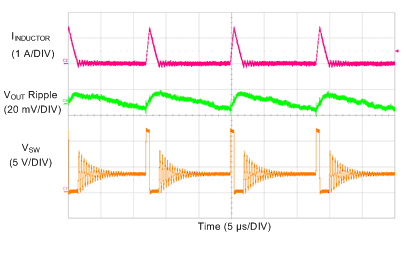
| VIN = 12 V | VOUT = 3.3 V | fSW = 500 kHz |
| IOUT = 100 mA | Auto Mode |

| VIN = 12 V | VOUT = 3.3 V | fSW = 500 kHz |
| IOUT = 6 A | Auto Mode |
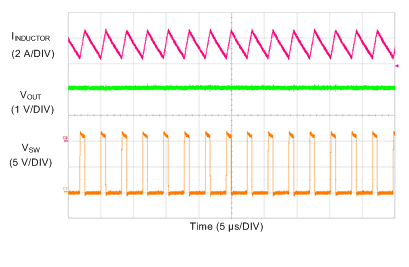
| VIN = 12 V | VOUT set at 3.3 V | fSW set at 500 kHz |
| IOUT = 7.5 A | VOUT droops to 2 V |

| VIN = 12 V | VOUT = 3.3 V | fSW = 500 kHz |
| IOUT= 200 mA | FPWM Mode |
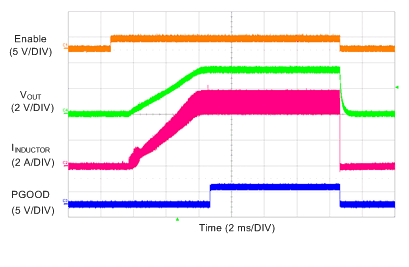
| VIN = 12 V | VOUT = 3.3 V | fSW = 500 kHz |
| IOUT = 5 A | Auto Mode |
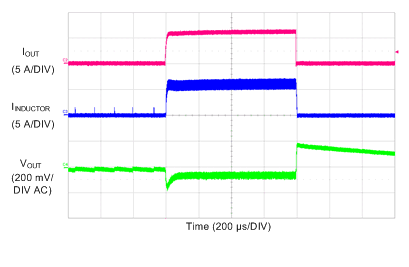
| VIN = 12 V | VOUT = 3.3 V | fSW = 500 kHz |
| IOUT = 10 mA to 6 A to 10 mA | Auto Mode | |
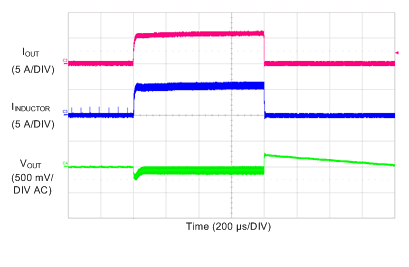
| VIN = 12 V | VOUT = 5 V | fSW = 2200 kHz |
| IOUT = 10 mA to 5 A to 10 mA | Auto Mode | |
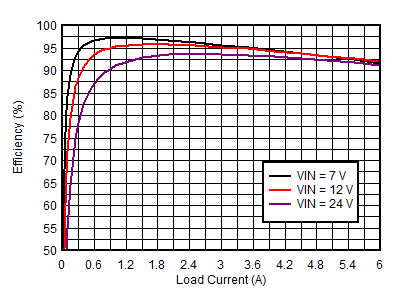
| VOUT = 5 V | fSW = 500 kHz | FPWM Mode |

| VOUT = 5 V | fSW = 1000 kHz | FPWM Mode |

| VOUT = 5 V | fSW = 2200 kHz | FPWM Mode |

| VOUT = 5 V | fSW = 500 kHz | FPWM Mode |

| VOUT = 5 V | fSW = 2200 kHz | FPWM Mode |
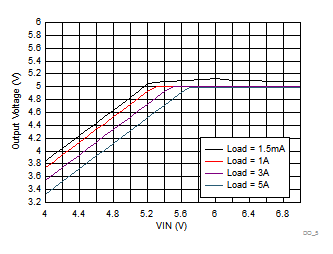
| VOUT = 5 V | fSW = 1000 kHz | Auto Mode |

| VOUT = 12 V | fSW = 500 kHz | Auto Mode |

| VIN = 12 V | VOUT = 3.3 V | fSW = 500 kHz |
| IOUT = 1 mA | FPWM Mode |

| VIN = 12 V | VOUT = 3.3 V | fSW = 500 kHz |
| IOUT = 100 mA | FPWM Mode |

| VIN = 3.66 V | VOUT = 3.3 V | fSW set at 500 kHz |
| IOUT = 3 A | Auto Mode |

| VIN = 12 V | VOUT = 3.3 V | fSW = 500 kHz |

| VIN = 12 V | VOUT = 3.3 V | fSW = 500 kHz |
| IOUT= 200 mA | Auto Mode |

| VIN = 12 V | VOUT = 3.3 V | fSW = 500 kHz |
| VPRE-BIAS= 1.5 V | Auto Mode |

| VIN = 12 V | VOUT = 3.3 V | fSW = 500 kHz |
| IOUT = 10 mA to 6 A to 10 mA | FPWM Mode | |

| VIN = 12 V | VOUT = 5 V | fSW = 2200 kHz |
| IOUT = 10 mA to 5 A to 10 mA | FPWM Mode | |